
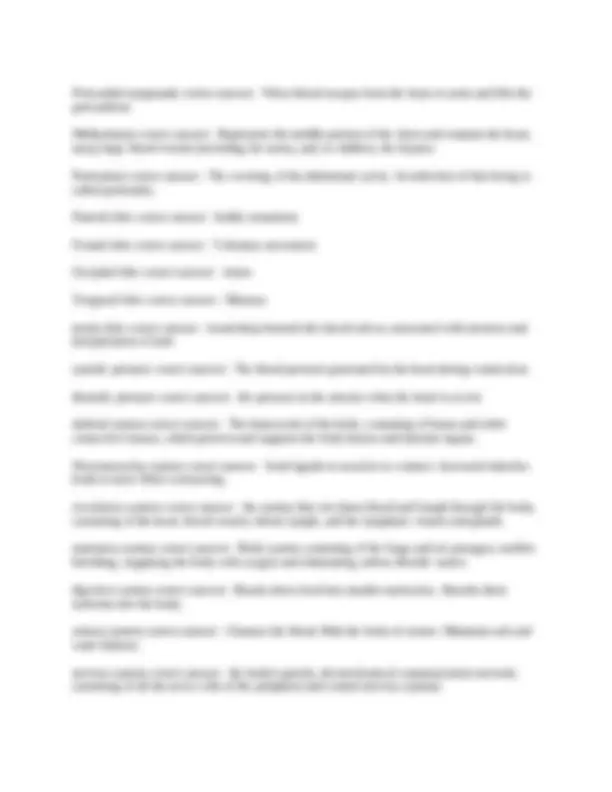
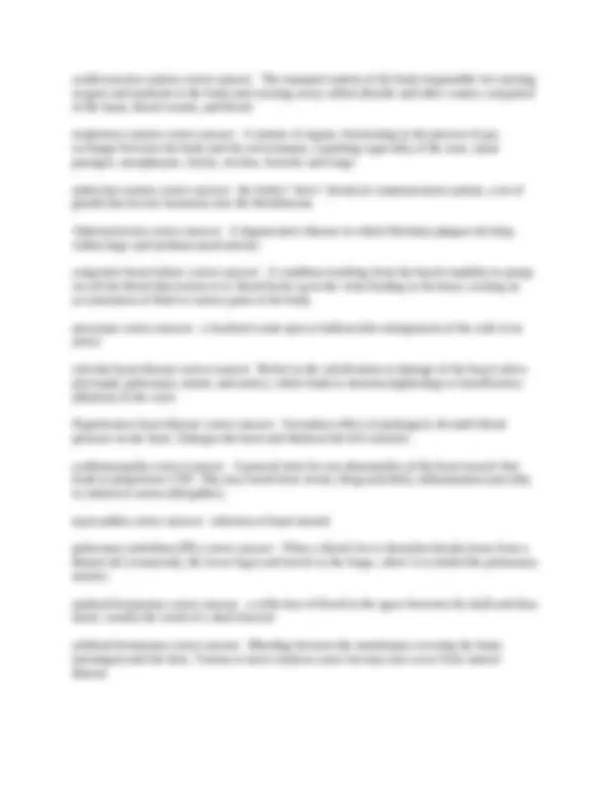
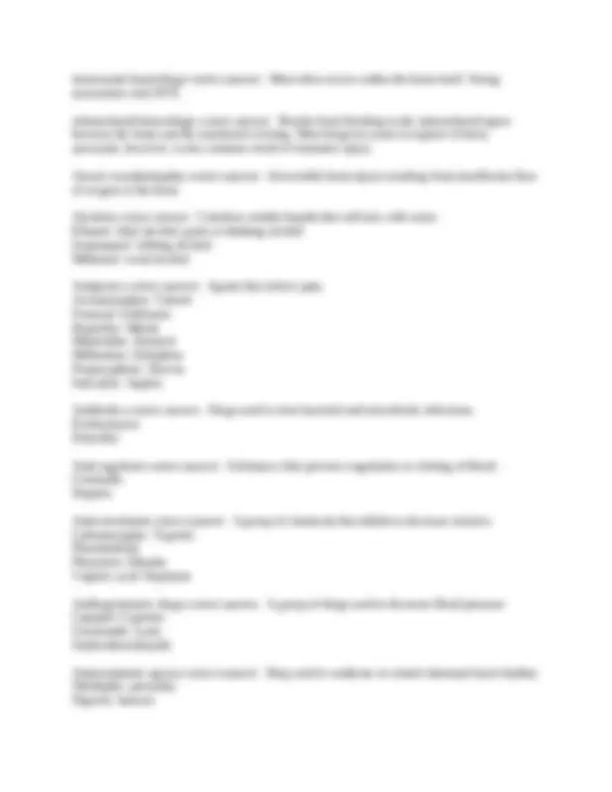
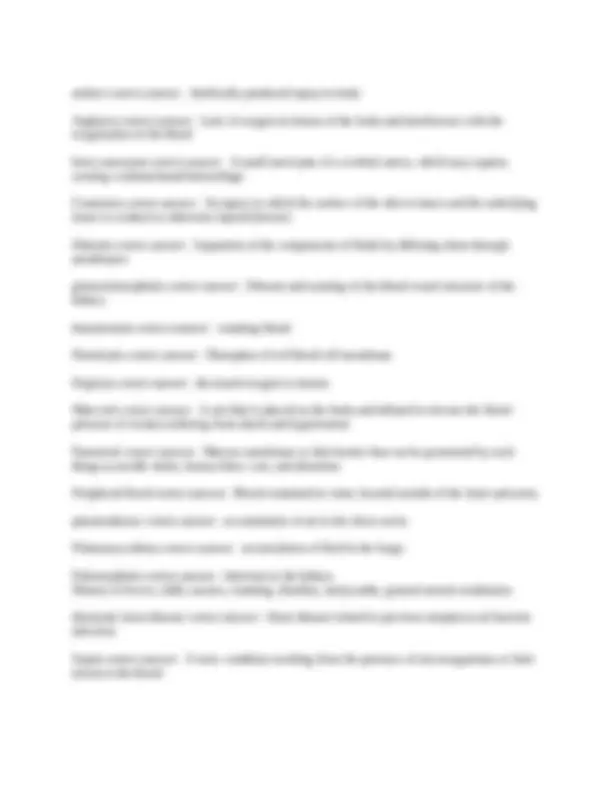

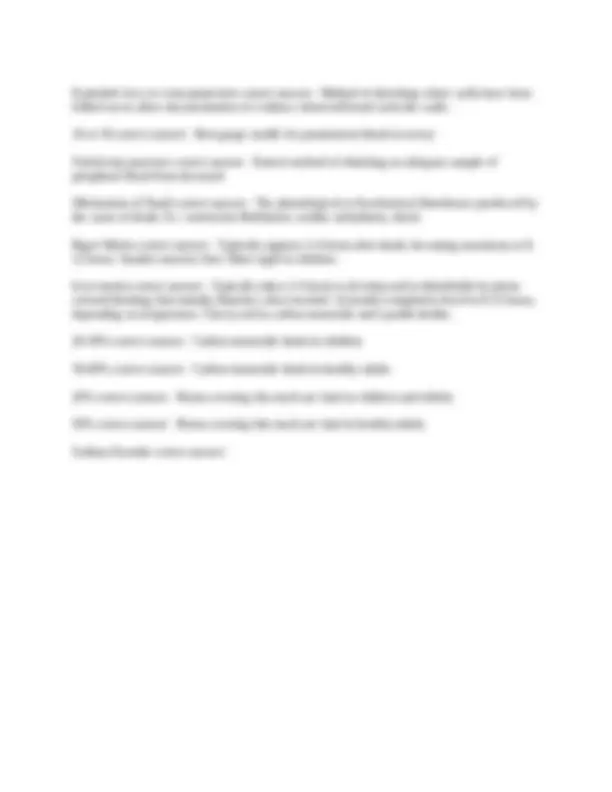


Study with the several resources on Docsity

Earn points by helping other students or get them with a premium plan


Prepare for your exams
Study with the several resources on Docsity

Earn points to download
Earn points by helping other students or get them with a premium plan
Community
Ask the community for help and clear up your study doubts
Discover the best universities in your country according to Docsity users
Free resources
Download our free guides on studying techniques, anxiety management strategies, and thesis advice from Docsity tutors
Definitions and correct answers for various anatomical terms, including their correct locations in the body. Topics covered include directions (superior, inferior, medial, lateral, proximal, distal, superficial, deep, anterior, and posterior), bones and structures (sternal notch, costal margin, umbilicus, pectoral girdle, sacrum, coccyx, dorsum, thorax and thoracic cavity, pericardium, mediastinum, peritoneum, frontal lobe, occipital lobe, temporal lobe, insula lobe, systolic pressure, diastolic pressure, skeletal system, neuromuscular system, circulatory system, respiratory system, endocrine system, atherosclerosis, congestive heart failure, aneurysm, valvular heart disease, hypertensive heart disease, cardiomyopathy, myocarditis, pulmonary embolism, epidural hematoma, subdural hematoma, intracranial hemorrhage, and various drugs and medical procedures.
Typology: Exams
1 / 10

This page cannot be seen from the preview
Don't miss anything!







Anacephalic correct answer: An infant born without a brain. Coronal plane correct answer: The plane that divides the body into front and back (e.g, anterior [ventral] and posterior [dorsal]) halves Mid-sagittal plane correct answer: The plane that divides the body into right and left halves Transverse correct answer: The plane that divides the body into top and bottom (e.g. superior [cephalad] and inferior [caudal]) halves Lateral correct answer: Surface or portion of the body that points toward the side or away from the midline of the body Medial correct answer: Describes any surface or portion of the body that points of faces toward the midline of the body (e.g., midsaggital plane) Proximal correct answer: Refers to a relative position that is farther away from the central portion of the body or origin of the structure (e.g., the position of the hand is distal to the shoulder) Superficial correct answer: Refers to a relative position close to the surface of an organ or close to the skin Deep correct answer: Refers to a relative position within the body or farther away from the surface of the body (e.g., farther from the surface) Auricular correct answer: The area of the ear Temporal correct answer: The side (lateral) surface of the head. Occipital correct answer: The back (posterior) surface of the head Parietal correct answer: The area considers the top of the head. This area abuts the frontal, temporal, and occipital regions Orbital correct answer: Area of the eye Sternal notch or angle correct answer: The junction of the sternum and the clavicle relating to the T4 to T5 level of vertebral bodies Submental correct answer: The area under the chin or jaw line
Costal margin correct answer: The lowest portion of the anterior ribs, corresponding to the level of the anterior attachment of the diaphragm and L3-L4 vertebral bodies Umbilicus correct answer: The naval Pectoral girdle correct answer: The muscles, bones, and other structures responsible for the attachment of the arm to the torso Axilla correct answer: The armpit region Epigastrium correct answer: The upper portion of the abdomen bordered by the costal margin Cervical correct answer: Refers to the upper (superior) portion of the spine Thoracic correct answer: Refers to the middle portion of the spine, which defines the thoracic cavity. Ribs attach to each of the thoracic vertebrae Lumbar correct answer: Refers to the lower portion of the spine (small of the back) Sacrum correct answer: Refers to the normally fused portion of the lower spine, which constitutes the back (posterior) region of the pelvic bones Coccyx correct answer: Tail bone Volar correct answer: The front (anterior, ventral) surface of the forearms and hands. The term "palmar" is used in this context with respect to the hands. Antecubital correct answer: The front (anterior, ventral) surface of the elbow where the arm and forearm meet. AKA antecubital fossa and is a common site for IV catheters and need punctures Tibia correct answer: The bone that defines the inner (medial) aspect of the lower (inferior) portion of the leg. The front (anterior) surface of this bone constitutes a portion of the shin (aka the pretibial region) Fibula correct answer: The bone that defines the outer (lateral) aspect of the lower (inferior) portion of the leg Plantar correct answer: The bottom surface of the foot Dorsum correct answer: The top surface of the foot Thorax and thoracic cavity correct answer: Contains the lungs and heart; pleural spaces enclose the lungs under the skeletal system Pericardium correct answer: The cavity containing the heart; it consists of a fibrous connective tissue.
cardiovascular system correct answer: The transport system of the body responsible for carrying oxygen and nutrients to the body and carrying away carbon dioxide and other wastes; composed of the heart, blood vessels, and blood. respiratory system correct answer: A system of organs, functioning in the process of gas exchange between the body and the environment, consisting especially of the nose, nasal passages, nasopharynx, larynx, trachea, bronchi, and lungs. endocrine system correct answer: the body's "slow" chemical communication system; a set of glands that secrete hormones into the bloodstream Atherosclerosis correct answer: A degenerative disease in which fibrofatty plaques develop within large and medium-sized arteries congestive heart failure correct answer: A condition resulting from the heart's inability to pump out all the blood that returns to it; blood backs up in the veins leading to the heart, causing an accumulation of fluid in various parts of the body aneurysm correct answer: a localized weak spot or balloon-like enlargement of the wall of an artery valvular heart disease correct answer: Refers to the calcification or damage of the heart valves (tricuspid, pulmonary, mitral, and aortic), which leads to stenosis (tightening) or insufficiency (dilation) of the valve Hypertensive heart disease correct answer: Secondary effect of prolonged, elevated blood pressure on the heart. Enlarges the heart and thickens the left ventricle. cardiomyopathy correct answer: A general term for any abnormality of the heart muscle that leads to progressive CHF. This may result from toxins, drugs (alcohol), inflammation (sarcoid), or unknown causes (idiopathic). myocarditis correct answer: infection of heart muscle pulmonary embolism (PE) correct answer: When a blood clot or thrombus breaks loose from a distant site (commonly, the lower legs) and travels to the lungs, where it occluded the pulmonary arteries epidural hematoma correct answer: a collection of blood in the space between the skull and dura mater, usually the result of a skull fracture subdural hematoma correct answer: Bleeding between the membranes covering the brain (meninges) and the dura. Trauma is most common cause but may also occur from natural disease.
intracranial hemorrhage correct answer: Most often occurs within the brain itself. Strong association with HTN. subarachnoid hemorrhage correct answer: Results from bleeding in the subarachnoid space between the brain and the arachnoid covering. Most frequent causes is rupture of berry aneurysm; however, is also common result of traumatic injury. Anoxic encephalopathy correct answer: Irreversible brain injury resulting from insufficient flow of oxygen to the brain Alcohols correct answer: Colorless volatile liquids that will mix with water. Ethanol: ethyl alcohol, grain or drinking alcohol Isopropanol: rubbing alcohol Methanol: wood alcohol Analgesics correct answer: Agents that relieve pain. Acetaminophen: Tylenol Fentanyl: Sublimaze Ibuprofen: Motrin Meperidine: Demerol Methadone: Dolophine Propoxyphene: Darvon Salicylate: Aspirin Antibiotics correct answer: Drugs used to treat bacterial and microbiotic infections. Erythromycin Penicillin Anticoagulants correct answer: Substances that prevent coagulation or clotting of blood. Coumadin Heparin Anticonvulsants correct answer: A group of chemicals that inhibit or decrease seizures Carbamezapine: Tegretol Phenobarbital Phenytoin: Dilantin Valporic acid: Depakane Antihypertensive drugs correct answer: A group of drugs used to decrease blood pressure. Capopril: Caproten Furosemide: Lasix Hydrochlorothiazide Antiarryptomic agency correct answer: Drug used to eradicate or control abnormal heart rhythm. Nifedipine: procardia Digoxin: lanoxin
Imipramine (Tofranil) Nortriptyline (Aventyl) GastroECtomy correct answer: Removal of all of part of the stomach GastrOStomy correct answer: Surgical formation of a connection between the stomach and the abdominal wall to bypass an obstruction or as a route of feeding Exploratory laporatomy correct answer: Surgical opening of the abdomen Colostomy correct answer: surgical formation of an artificial anus by connecting the colon to an opening in the abdominal wall orchiectomy correct answer: removal of one or both testes Thoracostomy correct answer: Surgical creation of an opening into the chest endarterectomy correct answer: Removal of obstructions, typically blood clots or plaque material, from occluded arteries laminectomy correct answer: the surgical removal of a lamina, or posterior portion, of a vertebra oophorectomy correct answer: surgical removal of an ovary -ectomy correct answer: Procedure done to remove something -ostomy correct answer: Operative procedure in which an artificial opening is created -otomy correct answer: Procedure done for the purpose of entering something, creating a hole that is usually surgically closed -plasty correct answer: Procedure done to restructure a portion of the anatomy, usually without removing anything Abrasion correct answer: Superficial loss of skin by process of friction Anemia correct answer: a deficiency of red blood cells Angiography correct answer: The radiographic visualization of blood vessels after they are filled with contrast media Antibody correct answer: A protein that attaches to or inactivated a specific antigen anticoagulant correct answer: A chemical that prevents blood from clotting Antigen correct answer: A protein that stimulates the production of a certain antibody
artifact correct answer: Artificially produced injury to body Asphyxia correct answer: Lack of oxygen in tissues of the body and interference with the oxygenation of the blood berry aneurysm correct answer: A small aneurysm of a cerebral artery, which may rupture, causing a subarachnoid hemorrhage Contusion correct answer: An injury in which the surface of the skin is intact and the underlying tissue is crushed or otherwise injured (bruise) Dialysis correct answer: Separation of the components of fluids by diffusing them through membranes glomerulonephritis correct answer: Fibrosis and scarring of the blood vessel structure of the kidney hematemesis correct answer: vomiting blood Hemolysis correct answer: Disruption of red blood cell membrane Hypoxia correct answer: decreased oxygen to tissues Mast suit correct answer: A suit that is placed on the body and inflated to elevate the blood pressure of victims suffering from shock and hypotension Parenteral correct answer: Mucous membrane or skin barrier that can be penetrated by such things as needle sticks, human bites, cuts, and abrasions Peripheral blood correct answer: Blood contained in veins, located outside of the heart and aorta pneumothorax correct answer: accumulation of air in the chest cavity Pulmonary edema correct answer: accumulation of fluid in the lungs Pyleonephritis correct answer: Infection in the kidney History of fevers, chills, nausea, vomiting, diarrhea, tachycardia, general muscle tenderness rheumatic heart disease correct answer: Heart disease related to previous streptococcal bacteria infection Sepsis correct answer: A toxic condition resulting from the presence of microorganisms or their toxins in the blood
Exploded view or cross-projection correct answer: Method of sketching where walls have been folded out to allow documentation of evidence observed/found on/in the walls. 16 or 18 correct answer: Best gauge needle for postmortem blood recovery Subclavian puncture correct answer: Easiest method of obtaining an adequate sample of peripheral blood from deceased Mechanism of Death correct answer: The physiological or biochemical disturbance produced by the cause of death. Ex: ventricular fibrillation, cardiac arrhythmia, shock Rigor Mortis correct answer: Typically appears 2-4 hours after death, becoming maximum at 8- 12 hours. Smaller muscles first. More rapid in children. livor mortis correct answer: Typically takes 2-4 hours to develop and is identifiable by plum- colored blushing that initially blanches when touched. Generally completely fixed in 8-12 hours, depending on temperature. Cherry-red in carbon monoxide and cyanide deaths. 20-30% correct answer: Carbon monoxide death in children 50-80% correct answer: Carbon monoxide death in healthy adults 20% correct answer: Burns covering this much are fatal in children and elderly 50% correct answer: Burns covering this much are fatal in healthy adults Sodium fluoride correct answer: